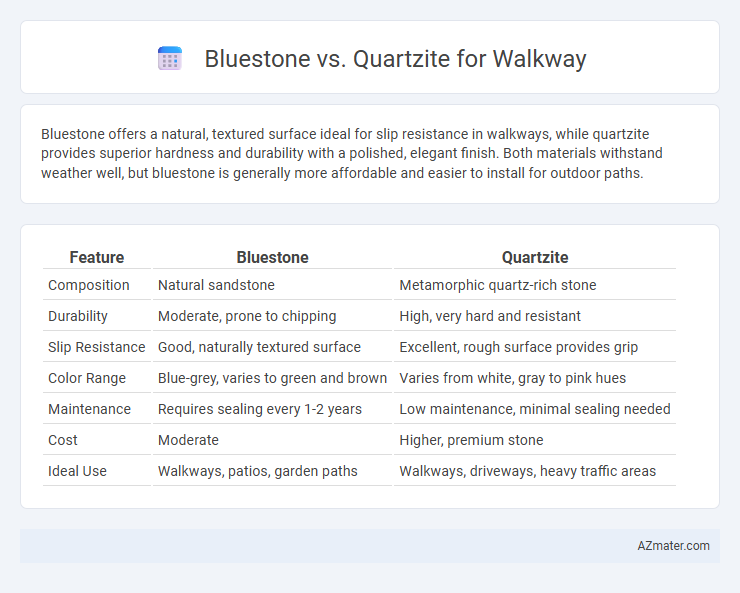Bluestone offers a natural, textured surface ideal for slip resistance in walkways, while quartzite provides superior hardness and durability with a polished, elegant finish. Both materials withstand weather well, but bluestone is generally more affordable and easier to install for outdoor paths.
Table of Comparison
| Feature | Bluestone | Quartzite |
|---|---|---|
| Composition | Natural sandstone | Metamorphic quartz-rich stone |
| Durability | Moderate, prone to chipping | High, very hard and resistant |
| Slip Resistance | Good, naturally textured surface | Excellent, rough surface provides grip |
| Color Range | Blue-grey, varies to green and brown | Varies from white, gray to pink hues |
| Maintenance | Requires sealing every 1-2 years | Low maintenance, minimal sealing needed |
| Cost | Moderate | Higher, premium stone |
| Ideal Use | Walkways, patios, garden paths | Walkways, driveways, heavy traffic areas |
Introduction to Bluestone and Quartzite Walkways
Bluestone and quartzite are popular natural stone choices for walkways due to their durability and aesthetic appeal. Bluestone, a dense and fine-grained sandstone, offers rich blue-gray hues and a smooth texture that provides slip resistance and weather resilience. Quartzite, a metamorphic rock known for its hardness and vibrant colors ranging from white to pink and green, delivers exceptional strength and low maintenance, making it ideal for high-traffic paths.
Key Characteristics of Bluestone
Bluestone is a dense, durable sandstone known for its smooth texture and natural blue-gray color, making it a popular choice for walkways due to its slip-resistant surface. Its ability to withstand heavy foot traffic and resist weathering contributes to long-lasting outdoor paths. Bluestone's variation in thickness and ease of cutting into custom shapes allows for versatile and aesthetically pleasing walkway designs.
Essential Properties of Quartzite
Quartzite is a highly durable natural stone known for its exceptional hardness and resistance to abrasion, making it ideal for walkways subjected to heavy foot traffic. Its non-porous surface enhances weather and stain resistance, ensuring longevity and low maintenance in outdoor settings. Unlike bluestone, quartzite offers superior slip resistance due to its textured surface, providing safer footing in wet or icy conditions.
Aesthetic Differences: Color and Texture
Bluestone offers a soothing color palette ranging from slate blue to gray with a naturally smooth texture that creates a sleek, uniform walkway surface. Quartzite stands out with its vibrant variety of hues including whites, pinks, and greens, coupled with a rougher, grainy texture that enhances slip resistance and adds rustic charm. The choice between bluestone and quartzite for walkways hinges on desired aesthetic impact--bluestone delivers a classic, elegant look while quartzite provides a more dynamic, textured visual appeal.
Durability and Weather Resistance Comparison
Bluestone offers excellent durability with moderate weather resistance, making it suitable for walkways in milder climates where freeze-thaw cycles are less intense. Quartzite provides superior durability and exceptional weather resistance, with high density and hardness that withstand heavy foot traffic, moisture, and temperature fluctuations without cracking or eroding. For walkways exposed to harsh weather conditions, quartzite is the preferred choice due to its resilience against frost damage, UV exposure, and general wear over time.
Maintenance Requirements for Each Stone
Bluestone requires regular sealing to prevent staining and minimize water absorption, with routine cleaning using mild soap and water to maintain its slip-resistant surface. Quartzite demands less frequent sealing due to its dense, hard structure but benefits from periodic cleaning to avoid dirt buildup and preserve its natural shine. Both stones are durable choices for walkways, yet Bluestone's porous nature results in higher maintenance compared to the low-maintenance quartzite option.
Slip Resistance and Safety Considerations
Bluestone offers superior slip resistance for walkways due to its natural cleft finish, providing a textured surface that enhances traction even when wet. Quartzite, while harder and more durable, typically has a smoother finish that can become slippery under moisture, requiring additional surface treatments or anti-slip coatings to improve safety. Prioritizing bluestone for walkways ensures a safer, slip-resistant pathway, especially in areas prone to rain or ice.
Cost Analysis: Bluestone vs Quartzite
Bluestone typically costs between $6 to $11 per square foot, making it a more affordable option for walkways compared to quartzite, which ranges from $12 to $20 per square foot due to its premium durability and aesthetic appeal. Installation expenses also vary, with quartzite requiring specialized cutting and handling, increasing labor costs by 15-25% over bluestone. Long-term maintenance costs favor quartzite as its high resistance to staining and weathering reduces upkeep expenses, balancing the initial investment difference over time.
Installation Process and Recommendations
Bluestone offers a straightforward installation process due to its consistent thickness and natural cleft surface, allowing for easy leveling and secure placement in walkways. Quartzite, being harder and denser, requires specialized cutting tools and additional labor to achieve precise fitting, making installation more labor-intensive and time-consuming. For durability and low maintenance, quartzite is recommended for high-traffic areas, while bluestone suits projects prioritizing ease of installation and aesthetic uniformity.
Best Applications and Final Selection Tips
Bluestone offers superior slip resistance and natural cleft texture, making it ideal for shaded walkways and areas prone to moisture. Quartzite provides exceptional durability and a range of vibrant colors, perfect for high-traffic paths requiring long-lasting strength and aesthetic appeal. When choosing between bluestone and quartzite, consider local climate conditions, maintenance requirements, and desired surface finish to ensure optimal safety and visual integration.

Infographic: Bluestone vs Quartzite for Walkway
 azmater.com
azmater.com